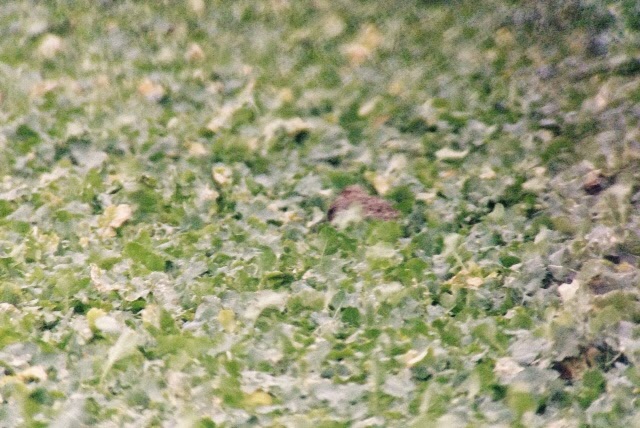It soon became obvious there was very little in the way of passerines on the island and a quick glance at the sea suggested that was also devoid of much avian life. Luckily there were plenty of waders of both the feathered and non feathered variety to keep me occupied. A trip up to the north end slipway resulted in 8 Purple Sandpipers among the Turnstones and Oystercatchers. A left leg ringed Rock Pipit was also present. With the heligoland traps depressingly empty I headed back to the Obs to light the fire and get a brew.
Standing on the balcony I became aware of two people trying to wade across to Middle Eye from Hilbre. They'd obviously miscalculated the tide and were now trying to get off. Unfortunately they didn't make it without both falling over and getting soaked. As I watched another couple appeared and tried the same thing. This couple fared slightly better but still got soaked! Unsure as to whether or not they could still get from Middle Eye back to West Kirby I rang Chris who got the coast guard to contact me. As I was speaking to them the people on Middle made a 999 call asking for help and the West Kirby inshore lifeboat was launched. It made two trips to take them back to West Kirby marine lake car park. A lesson learnt I think - people don't realise how quickly the tide around Hilbre races in and can cut you off.
Once this excitement was over I turned my attention to the WeBs count. There was very little on the sea with 2 Great-crested grebes, 2 Common Scoter, a single Red-throated Diver and the highlight in the form of 2 pairs of Goldeneye! The Brents were on the sea between Little Eye and West Kirby and allowed an accurate count of 223 birds.
Waders were roosting all around me. Niffy bay held a good number of Turnstones and a few Redshank with a single Purple Sandpiper on the 'steps' for good measure. One of the Turnstones was one of our colour ringed birds from 2010 whilst a Redshank bore a metal ring on its right leg so obviously wasn't one of ours as we ring on the left leg.
Colour ringed Turnstone red over light green right leg. This bird will have a metal BTO ring on its left leg
Metal ringed Redshank - right leg.
Turnstone bathing.
The Purple Sandpipers weren't roosting in their usual place which was surprising but I eventually found 3 roosting on the west side cliffs.
A small flock of 23 Ringed Plovers roosted on top of the west side cliffs and there were a few Dunlin among them.
After a tour of the island trying to track down roosting waders I returned to the Obs to 'scope Middle Eye and check the roosting waders there. As usual Oystercatchers dominated but there was also a decent sized flock of Curlew and a few Knot present.
The distance is just a bit far to try and pick out any colour rings on the Oystercatchers which is a shame as it would be nice to confirm movement between N Wales and the Dee by picking out one of the SCAN colour ringed birds. One has been seen recently but the ring number couldn't be read
The only downside of a late tide is that I had to drive off in the dark so didn't have the opportunity to photograph any waders feeding alongside the Landrover.
A great weekends birding - its just a shame I couldn't attend SCAN's Sunday canon netting session as they had another good catch!




















































































